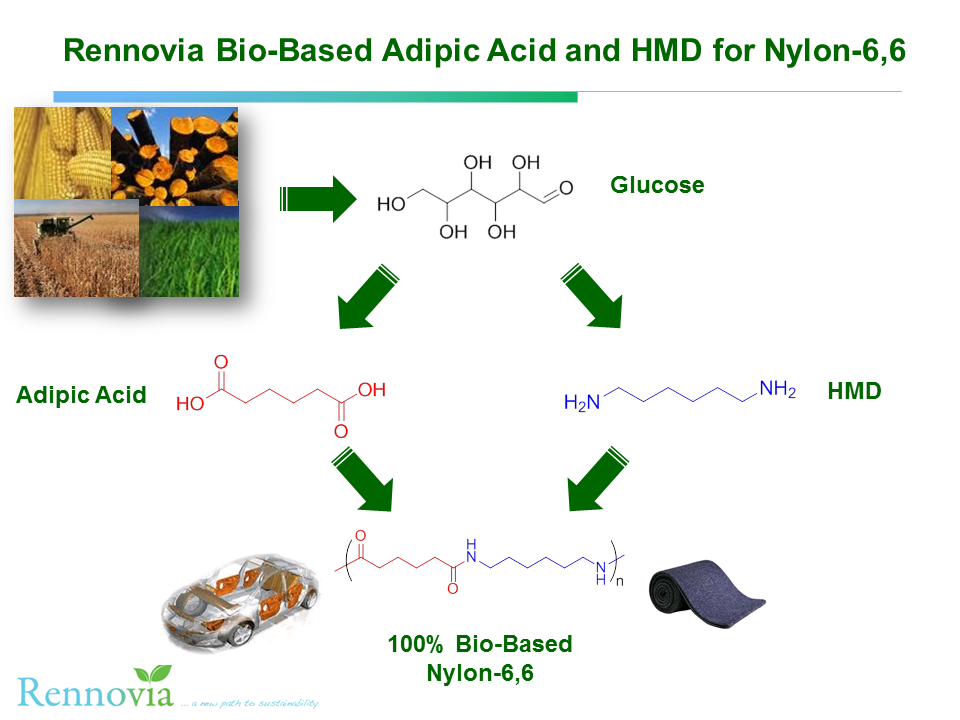It has been awhile since the blog heard from US bio-adipic acid producer Rennovia. Today, the company puts out a press release that it has successfully demonstrated production of hexamethylenediamine (HMD) from renewable feedstock
Now, some of you are probably wondering what is HMD? Some actually use the acronym HMDA for this chemical, which is one of the precursors for the production of nylon 6,6 aside from adipic acid. HMD can also be produced using adipic acid (ADA) as feedstock. Here is a simplified chart that Rennovia sent:
According to Rennovia, the market for HMDA (or HMD) is currently over 3bn pounds/year with a value of more than $4bn. The chemical intermediate is currently produced from petroleum-derived propylene or butadiene. Rennovia said it has developed a lower cost route of directly producing HMD from sugars without going through the bio-adipic acid process.
Nylon 6,6 is used in resin and fiber applications as well as in polyurethanes. End markets include exterior/interior/under-the-hood automotive parts, coatings, tires, carpeting and consumer goods such as shoes and apparel.
As you can see from the chart, with Rennovia being able to produce both bio-based ADA and bio-based HMD, the company is now able to develop a 100% bio-based nylon 6,6.
The company said production costs for its bio-based HMD are projected to be 20%-25% below that of conventional petroleum-based HMD with significantly lower per-pound capital cost. Projected benefits for the bio-based chemical also include a 50% reduction greenhouse gas emissions compared to conventional petroleum-derived HMD.
Rennovia’s next step is to produce bio-based HMD (and bio-based ADA) at a demonstration scale. Rennovia said it has already refined its glucaric acid-based adipic acid process after more than 18 months of pilot plant operation.
The company is targeting a commercial demonstration unit for bio-adipic acid by 2014 with a fully integrated “mini-plant designed to allow direct scale-up to the full commercial scale of 135,000 tons/year. Rennovia anticipates its first commercial-scale production in 2018.
Of course this target depends on getting financing but the company recently filed a special form (D Filing) at the US Securities and Exchange Commission (SEC) stating that it had raised $2m in private offering. In January, the company was also able to privately raise $28.4m as according to the company filing.
Rennovia is confident that its bio-based adipic acid will be highly cost-competitive not only against petroleum-based ADA but also other bio-based ADA that are currently being developed. Aside from Rennovia, other companies in the bio-based ADA development space include Verdezyne, BioAmber, DSM and Genomatica.
Conventional adipic acid production is currently via oxidation of cyclohexane. Major global producers of ADA, according to consulting firm IHS, include Invista, Ascend, Honeywell, BASF, Radici, China Shenma and PetroChina. Average ADA price last year was estimated at $1,600/metric ton and according to IHS, Rennovia’s process has a high potential to be cost competitive while Verdezyne’s process has also the potential to be cost-competitive (I guess not as high as Rennovia’s as implied by IHS).
This is because both bio-routes are said to have the advantage of using $300/metric ton of glucose feedstock compared to cyclohexane that had a market price of $1,250/metric ton last year. However, significant challenges for the bio-based routes, according to IHS, include Rennovia’s ability to achieve high feedstock selectivity and catalyst productivity, and in the case of Verdezyne, high enzyme turnover rates and satisfactory kinetics for Verdezyne’s enzyme fermentation route.
Rennovia said “these challenges is in reference to their very early patent examples and that the company is already very close to or exceeding their catalyst selectivity and productivity targets.”
The company, by the way will be presenting in June at the Bioplastek conference where the blog is a media partner.
FOLLOW ME ON THESE SPACE
Discussion
Comments are closed.